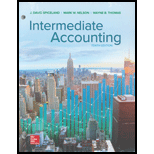
1
Concept Introduction:
Valuation of inventory: It is the cost associated with the cost of inventory at the end of the accounting period. It is based on the cost incurred by the entity to acquire the inventory. There are four generally applied
The inventory valuation using the first in first out method.
2
Concept Introduction:
Valuation of inventory: It is the cost associated with the cost of inventory at the end of the accounting period. It is based on the cost incurred by the entity to acquire the inventory. There are four generally applied inventory valuation techniques: Specific identification method, First in first out method, last in first out method, and weighted average cost method.
The value of inventory using average cost.
Want to see the full answer?
Check out a sample textbook solution
Chapter 8 Solutions
INTERMEDIATE ACCOUNTING <CUSTOM LL>
- I am searching for the accurate solution to this general accounting problem with the right approach.arrow_forwardPlease provide the correct answer to this general accounting problem using valid calculations.arrow_forwardCan you solve this general accounting problem using appropriate accounting principles?arrow_forward
- Sarah is the president and general manager of the operation. Sarah has been very proactive in growing the business. She has met with her banker to discuss expanding the facilities and equipment with another $150,000 loan. Their first loan for $150,000 was secured by the industrial-size food production equipment purchased with the loan. The banker now demands an audit of the corporate financial statements before releasing another loan to the company. Sarah has offered to place the corporate account receivables up as collateral to secure the second loan. Based on revenue projections by her sister Jillian's sales team, Sarah believes that the company will not have trouble paying down the loan in a short period of time. Kim's assistant, Henry, monitors the production and shipment of Smackey Dog Food's regular line of products. Henry takes pride in his work and is involved in every facet of the operation. With only one other warehouse employee to help, Henry personally is involved in…arrow_forwardI need assistance with this financial accounting problem using appropriate calculation techniques.arrow_forwardDodge Industries has the following data: direct labor $185,000, direct materials used $210,000, total manufacturing overhead $195,000, and beginning work in process $45,000. Compute total manufacturing costs and total cost of work in process.arrow_forward
- I am looking for the most effective method for solving this financial accounting problem.arrow_forwardTreadway Equipment acquired manufacturing machinery at the beginning of the year at a cost of $86,000. The machinery has an estimated residual value of $5,500 and an estimated useful life of 5 years. Determine the second-year depreciation using the straight-line method.arrow_forwardHow can I solve this financial accounting problem using the appropriate financial process?arrow_forward
- Principles of Accounting Volume 1AccountingISBN:9781947172685Author:OpenStaxPublisher:OpenStax College
 Financial AccountingAccountingISBN:9781337272124Author:Carl Warren, James M. Reeve, Jonathan DuchacPublisher:Cengage Learning
Financial AccountingAccountingISBN:9781337272124Author:Carl Warren, James M. Reeve, Jonathan DuchacPublisher:Cengage Learning Financial And Managerial AccountingAccountingISBN:9781337902663Author:WARREN, Carl S.Publisher:Cengage Learning,
Financial And Managerial AccountingAccountingISBN:9781337902663Author:WARREN, Carl S.Publisher:Cengage Learning,  Financial AccountingAccountingISBN:9781305088436Author:Carl Warren, Jim Reeve, Jonathan DuchacPublisher:Cengage Learning
Financial AccountingAccountingISBN:9781305088436Author:Carl Warren, Jim Reeve, Jonathan DuchacPublisher:Cengage Learning Intermediate Accounting: Reporting And AnalysisAccountingISBN:9781337788281Author:James M. Wahlen, Jefferson P. Jones, Donald PagachPublisher:Cengage Learning
Intermediate Accounting: Reporting And AnalysisAccountingISBN:9781337788281Author:James M. Wahlen, Jefferson P. Jones, Donald PagachPublisher:Cengage Learning Cornerstones of Financial AccountingAccountingISBN:9781337690881Author:Jay Rich, Jeff JonesPublisher:Cengage Learning
Cornerstones of Financial AccountingAccountingISBN:9781337690881Author:Jay Rich, Jeff JonesPublisher:Cengage Learning





